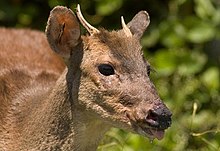Small red brocket
Appearance
| Small red brocket | |
|---|---|

| |
| Scientific classification | |
| Domain: | Eukaryota |
| Kingdom: | Animalia |
| Phylum: | Chordata |
| Class: | Mammalia |
| Order: | Artiodactyla |
| Family: | Cervidae |
| Subfamily: | Capreolinae |
| Genus: | Mazama |
| Species: | M. bororo
|
| Binomial name | |
| Mazama bororo Duarte, 1996
| |

| |
| Small red brocket range. Extant Probably extant | |
The small red brocket (Mazama bororo) is a small species of deer in the family Cervidae.[2] It is endemic to Atlantic Forest in Paraná, Santa Catarina and São Paulo in southeastern Brazil. This species, which only was scientifically described in 1996, is threatened by habitat loss.[1] Though its size and structure most resemble that of the pygmy brocket (M. nana), its coloration is very similar to that of the red brocket (M. americana).[3] It resembles hybrids between these two species even more closely, but differs from both, and their hybrids, in karyotype.[4]
References
- ^ a b Vogliotti, A.; Oliveira, M.L.; Duarte, J.M.B (2016). "Mazama bororo". IUCN Red List of Threatened Species. 2016: e.T41023A22155086. doi:10.2305/IUCN.UK.2016-1.RLTS.T41023A22155086.en. Retrieved 11 November 2021.
- ^ Grubb, P. (2005). "Order Artiodactyla". In Wilson, D.E.; Reeder, D.M (eds.). Mammal Species of the World: A Taxonomic and Geographic Reference (3rd ed.). Johns Hopkins University Press. pp. 637–722. ISBN 978-0-8018-8221-0. OCLC 62265494.
- ^ Vogliotti, A., and J. M. B. Duarte (2009). Discovery of the first wild population of the small red brocket deer Mazama bororo (Artiodactyla: Cervidae). Mastozool. Beotrop. 16(2).
- ^ Duarte, J. M. B., and W. Jorge. (2003). Morphologic and cytogenetic description of the small red brocket (Mazama bororo Duarte, 1996) in Brazil. Mammalia 67: 403-410.

